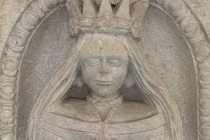It should come as no surprise that Türkiye is home to a wealth of spectacular Ottoman mosques. The six-hundred-year Ottoman state left a powerful mark between its foundation in 1299, to its demise in 1923. This is especially true of the empire’s former capital Istanbul, and its heartlands in Anatolia and Thrace.
What is particularly impressive however, is the way they vary in appearance from time to place.
Here are five of these majestic marvels dating from oldest to newest:
Grand Mosque, Bursa (completed 1399)

Bursa’s Grand Mosque or Ulu Cami is a celebrated landmark of early Ottoman architecture. Sultan Bayezid I – also known as “Yıldırım” or “the Thunderbolt” – commissioned the house of prayer to celebrate his triumph over a crusader army at Nikopol, Bulgaria in 1396.
To this day, one of the mosque’s most unique attributes is its twenty iconic domes, and an interesting account offers an explanation as to how the mosque may have come to look this way. It is said that the sultan had initially wanted to build twenty separate mosques after his victory, but that his son-in-law Emir Sultan and one of his scholars had advised him to build a single large one with twenty domes instead.
Among the Ulu Camii’s other noteworthy features are an indoor water fountain for worshippers to purify themselves before prayers, and stunning nineteenth-century Arabic calligraphy.
Hacı Bayram Mosque, Ankara (completed 1427/28)
Despite his victory at Nikopol however, Sultan Bayezid suffered a defeat at the hands of the Turco-Mongol ruler Timur – also known as Tamerlane – at Ankara in 1402. Around a quarter century after that loss, the central Anatolian city, now Türkiye’s capital, was blessed with one of its best-known places of worship, the Hacı Bayram Mosque. The mosque takes its name from the religious teacher Hacı Bayram Veli whose tomb sits beside it.
Having undergone numerous restorations, the structure looks different than its original form, instead more closely resembling its seventeenth and eighteenth-century counterparts.

Made from brick and sporting a tile roof and a single minaret with two balconies, the building’s external appearance is charmingly simple. On the inside, however, Hacı Bayram boasts an impressive plaster prayer niche or mihrab indicating the direction of Mecca, decorated with beautiful Quranic inscriptions, making it a sight to behold.
Selimiye Mosque, Edirne (completed 1574/75)
Perhaps the most widely known Ottoman mosques, however, are built in what is often referred to as the “classical” style. These usually resemble Istanbul’s iconic Hagia Sophia, cubic in shape with pencil-like pointed minarets, and full domes, often complemented by additional half and quarter domes.
While many famous Istanbul mosques such as the Süleymaniye or Blue Mosque fall into this category, the Selimiye Mosque in Edirne (pictured top), near the Greek and Bulgarian borders, is perhaps the most magnificent manifestation of this tradition.
Endowed by Sultan Selim II (r.1566-1574), Selimiye’s architect Sinan the Great considered the house of prayer to be the best work of his career spanning the reigns of three sultans.
The mosque’s four slender minarets pierce Edirne’s skyline, while its large dome wows the eyes. Selimiye’s interior is no less resplendent, with its arches, columns and high ceilings creating a wide-open space for worshippers to soak up the atmosphere.
The mosque – now a UNESCO World Heritage Site – is also the centrepiece of a traditional Ottoman complex or külliye dedicated to public service and charitable works. The Selimiye külliye also houses a historic primary school, two Islamic educational institutions or medreses and a covered market, though the market is the only one of these four features still in active use today.
Nuruosmaniye Mosque, Istanbul (completed 1755)
Some may recognise Istanbul’s Nuruosmaniye Mosque from the opening chase scene in the Bond film Skyfall.
Nuruosmaniye sits beside the city’s iconic Grand Bazaar and was completed in the reign of Sultan Osman III (r.1754-1757). The eighteenth-century place of worship’s name translates to the “Light of Osman” and takes its name from a Quranic passage that reads “Allah is the Light of the Heavens and the Earth” which also adorns its interior dome.
Built at a time of increased European influence and modernisation in the empire however, the mosque embodies another architectural tradition sometimes known as “Ottoman Baroque”. This trend combines classical Ottoman style with European baroque influences. For this reason, Nuruosmaniye deviates somewhat from what had been the norm for many previous mosques.
Its courtyard, for instance, was built in an unprecedented horse-shoe shape as opposed to the more typical square or rectangular forms. Nuruosmaniye’s twin minarets also break from traditional style, using stone tips instead of lead.
Despite these changes, however, Nuruosmaniye’s social and religious purpose remained the same as that of other mosques. Like Selimiye, Nuruosmaniye is also part of a külliye, and was built with a medrese as well as a soup kitchen to feed those in need.
Yıldız Hamidiye Mosque, Istanbul (completed 1886)
Yıldız Hamidiye is perhaps Istanbul’s most unique Ottoman mosque. Completed in 1886 during the reign of Abdülhamid II (r.1876-1909), the magnificent structure was the last to be established by a sultan.
Yıldız was built by an Armenian architect named Sarkis Balyan, whose family, including his father and brother, built many of the Ottoman capital’s most famous nineteenth-century landmarks such as Dolmabahçe Palace.

The special mosque combines European neo-Gothic and Moorish-inspired features. The blue interior of the dome for instance, is decorated with Quranic inscriptions and – in keeping with its name – golden stars, “Yıldız” means star in Turkish after all. Meanwhile, the arches supporting the dome resemble those of Muslim Spain’s historic Alhambra Palace.
Yet, the most significant feature of the mosque is its deep and personal connection to Sultan Abdülhamid himself. A skilled carpenter, the sultan handcrafted wooden lattices that decorate Yıldız’s interior. Even more importantly, Sultan Abdülhamid regularly attended Friday prayers at the mosque throughout much of his reign.
So next time you are on your travels in Türkiye be sure to stop by one of these Ottoman wonders, you may be treading in the footsteps of royalty!
Main image, top, of Selimiye Mosque in Edirne, Dec. 2023. Photo © Kenan Talas/iStock





